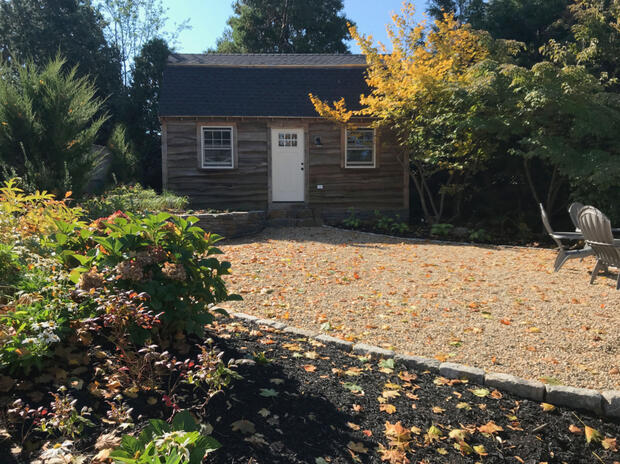Introduction
Impervious surfaces include asphalt driveways, concrete patios, rooftops, and other areas that do not allow water to infiltrate (i.e., filter into the ground). Stormwater running over these surfaces picks up and carries contaminants to local waterbodies. Lawns add to the problem when soils beneath them become compacted, increasing runoff that often carries fertilizers, pesticides, and other contaminants. Impervious surfaces also increase the volume and speed of stormwater runoff, which increases the frequency and intensity of local flooding and erosion. Replacing impervious cover with surfaces that infiltrate or absorb water—such as gravel driveways, pea gravel paths, and areas planted with perennials, shrubs, and trees—helps to reduce runoff pollution. In addition to strategies for reducing impervious surfaces on your property, this fact sheet provides practical steps for reducing the volume of stormwater runoff and slowing the flow of stormwater. Finally, specific advantages of using plants to reduce stormwater pollution are discussed.
Reducing impervious surfaces is an effective stormwater control method for any yard, even where space is limited for other stormwater control options. On coastal properties impacted by wind and waves, controlling runoff and planting deep-rooted vegetation has the added advantage of helping to reduce erosion and storm damage. See CZM’s Coastal Landscaping website for details.
Impacts to Neighboring Properties - Stormwater management practices must be designed to responsibly collect, convey, and/or infiltrate runoff from your property without transferring problems to neighboring properties, roads, and municipal drainage systems. Management practices that redirect or divert stormwater—such as disconnecting/redirecting downspouts or re-grading the land surface—can cause flooding problems in roadways or neighboring yards, basements, or leach fields (potentially causing a septic system failure). These projects must therefore be designed to ensure that stormwater is not transferred offsite. Carefully following design guidelines in the Stormwater Solutions for Homeowners fact sheets will help you avoid impacts to neighboring properties. If in doubt about offsite impacts, consult a professional, such as a civil engineer or landscape architect.

For properties near beaches, coastal banks, dunes, floodplains, rivers, salt marshes, wetlands, and other “resource areas” protected under the Massachusetts Wetlands Protection Act,* reducing stormwater impacts from impervious surfaces can be particularly beneficial. Projects directly next to or within these resource areas, however, are likely to require a permit through the local Conservation Commission. To maximize the benefits and avoid negative impacts to resources and adjacent properties, permitted projects must be properly designed, installed, and maintained. For example, regrading projects or those that redirect water flow should be sited so that runoff does not flow directly toward resource areas and cause erosion problems. In addition, short-term construction impacts must be avoided or minimized by providing erosion and sediment controls. Many municipalities have local regulations that require stormwater to be managed on site and not discharged to adjacent properties or municipal conveyance systems. The Massachusetts Department of Environmental Protection’s Structural BMP Specifications for the Massachusetts Stormwater Handbook (Volume 2, Chapter 2) (PDF, 6.5 MB) provides additional information and design requirements for stormwater control methods proposed in wetland resource areas and buffer zones. For any project, homeowners are encouraged to contact their local Conservation Commission before undertaking work to determine whether a resource area exists, what permitting requirements may apply, and how to avoid impacts.
*MGL Chapter 131, Section 40 and corresponding regulations at 310 CMR 10.00.
Reduce Impervious Surfaces
Runoff from asphalt, concrete, cement, and bricks can substantially increase local stormwater pollution—but these impervious materials are not the only option for creating flat, low-maintenance areas in your yard. The following approaches can reduce the extent and impact of impervious surfaces on your property:
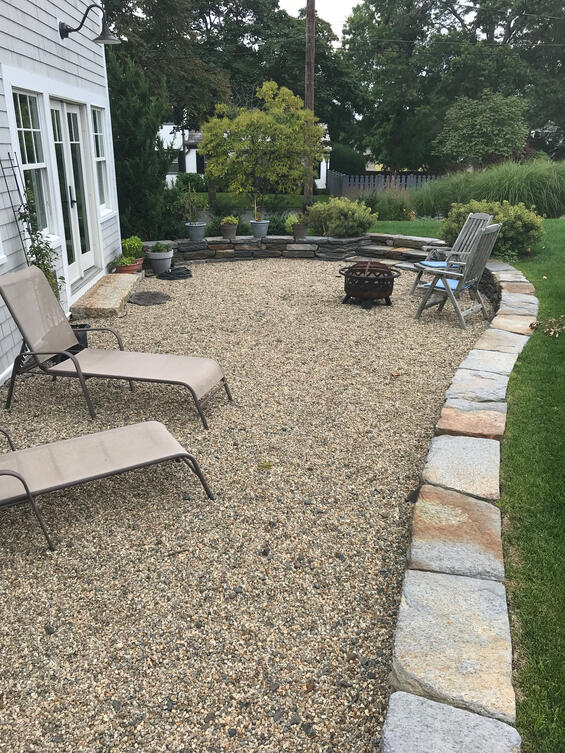
To allow rainwater to infiltrate, this patio was designed with pea gravel rather than mortared stone, bricks, or other impervious options.
- Minimize impervious areas - Reduce the footprint of impervious surfaces on your property (including buildings and other structures) and select alternative surfaces whenever possible. For example, rather than an impervious patio, choose a deck that allows more water to soak into the ground.
- Use pervious materials - Rather than using pavement or concrete for driveways, walkways, or patios, choose materials that can help capture and infiltrate stormwater, such as gravel, pea gravel, crushed shells, and mulch. To maintain these surfaces, you may need to periodically add new material or re-level the area. Permeable paving systems, such as paving stones or grass pavers, are another option (see the Massachusetts Clean Water Toolkit Permeable Paving page for details). Permeable pavers are particularly useful for driveways with steep grades where gravel or other materials may erode. (Consultation with an engineer is recommended for sites with steep slopes.) If you are removing existing asphalt or concrete, a contractor with specialized equipment may be needed to break up and remove the materials and transport them for disposal.
- Avoid products that cause compaction - Certain products, such as dense-grade aggregate or stone dust, prevent water from infiltrating. While these materials may seem more pervious than surfaces like concrete, they are designed to eliminate voids when compacted, causing the treated area to become impervious with use.
This planting bed, which replaced lawn area, helps absorb rain and infiltrate water before it flows to the road.
- Allow for infiltration between stones and bricks - For patios, walls, and steps, avoid the use of grout, mortar, cement, or sealers, and instead set them on a sand and gravel base to allow water to pass through the openings. Hardy groundcovers or moss can also be grown within patio joints to enhance water uptake.
- Reduce lawn areas - Though lawn is more pervious than paved surfaces, turf grass has shallow roots and the underlying area tends to become compacted, significantly reducing infiltration. Trees, shrubs, and perennials have deeper roots that both absorb the water and create pathways for stormwater to seep into the ground. Replacing lawn with other plantings, like shrub borders, perennial beds, wildflower fields, or dense groundcover that tolerates foot traffic is an excellent strategy for reducing runoff (see the Use Plants to Reduce Stormwater Pollution section for details). You can also significantly reduce compaction and improve infiltration in lawns with annual deep core aeration followed by top-dressing with compost. In addition, set mower heights to higher levels. Taller grasses not only help slow the flow of stormwater, they also retain more moisture, which reduces the need for watering and improves lawn health. See Stormwater Solutions for Homeowners Fact Sheet: “Green” Lawn and Garden Practices for details.
Decrease the Volume of Stormwater Runoff
The greater the volume of stormwater running offsite, the more significant the potential impacts to local water quality. These steps can help reduce the runoff that flows across impervious surfaces on your property:
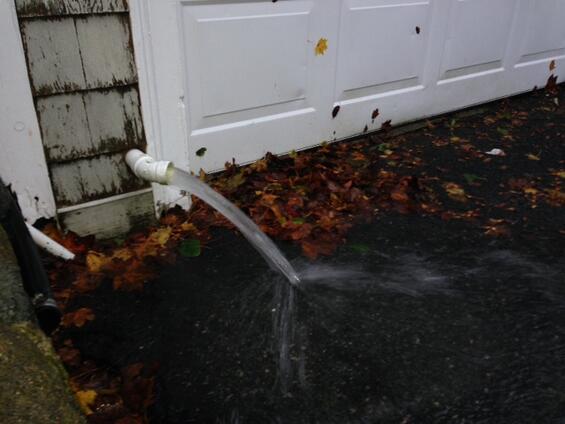
What NOT to do—This sump pump drains onto an asphalt driveway, causing contaminated runoff to flow directly into the road and nearby storm drains.
- Do not direct stormwater to hard surfaces - Eliminate direct connections of sump pumps, foundation drains, or gutters and downspouts to driveways, roadways, or other hard surfaces. Instead, direct the water to a vegetated surface, such as a rain garden or vegetated swale, where it can be infiltrated. (Caution: If you use a sump pump and ground pipe to drain water to a vegetated area, be sure to prevent the pipe from freezing so that water does not back up into your basement or overwork the pump.) See the Use Plants to Reduce Stormwater Pollution section of this fact sheet for more on vegetated surfaces.
- Improve drainage - For soils that do not effectively infiltrate water, such as compacted areas or clay deposits, options exist to help improve drainage. First, aerate or till the soil and mix it with sand, compost, or shredded bark mulch. These amendments will help loosen the soil, reduce compaction, and improve water retention and infiltration. Adding organic matter is especially important if drainage from roadways or parking lots is contributing road salts and sands that can damage soil structure and reduce soil quality. For more information, see the Massachusetts Clean Water Toolkit Soil Amendments page. If additional measures are needed to control runoff, drainage structures such as dry wells, curtain drains, and French drains can be used. See the Massachusetts Clean Water Toolkit’s Dry Wells page and Subsurface Drain page for details on these infiltration methods.
- Reduce lawn watering - Overwatering can lead to excessive runoff and leaching of nutrients through the soils. (By watering less, you also encourage lawns to grow deeper roots and become more conditioned to droughts.) For more information on environmentally friendly lawn care, see Stormwater Solutions for Homeowners Fact Sheet: “Green” Lawn and Garden Practices.
- Minimize roof runoff and reuse water - Drainage from rooftops can be directed to vegetated buffers, swales, or rain gardens, and rain barrels can be installed under downspouts to collect water for reuse (see the Stormwater Solutions for Homeowner fact sheet index to find additional information on these techniques). Directing roof runoff into a drywell is another option (see the Massachusetts Clean Water Toolkit’s Dry Wells page). In addition, a green roof (i.e., a roof specially designed to grow vegetation that absorbs stormwater) can be used in buildings that can structurally support the weight of the soils and plantings. For additional information on green roofs and their benefits, see the Mass.gov Green Roofs & Stormwater Management web page, Massachusetts Clean Water Toolkit Green Roofs page, and Metropolitan Area Planning Council’s Green Roofs fact sheet.
Slow the Flow of Stormwater
Fast flowing runoff can cause erosion, which not only impacts your property but degrades waterways with silt and other sediments. Follow these strategies to help slow stormwater and prevent erosion (for information on managing stormwater that flows off construction sites, see Stormwater Solutions for Homeowners Fact Sheet: Preventing Erosion).
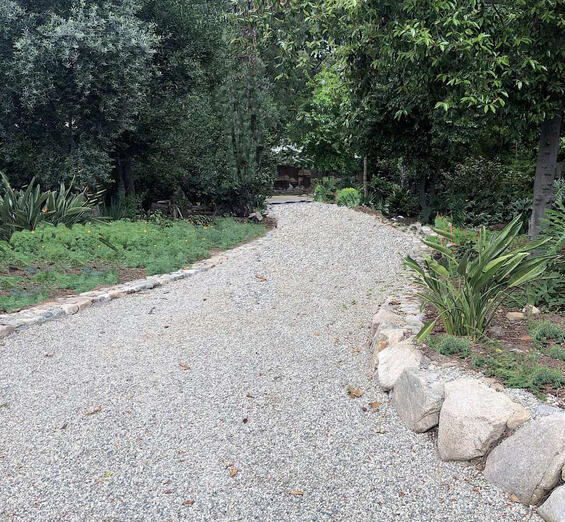
This curved, pea gravel driveway helps infiltrate water and prevents runoff from flowing directly to the road.
- Design driveways and walkways to slow flows - Driveways and walkways (or portions of them) can be narrowed or curved to help slow the rate of stormwater flow. Replacing smooth impervious surfaces with gravel, pea gravel, and other pervious materials—or using permeable paving systems—also helps create friction that slows stormwater flows. Where asphalt or concrete is used, minimize impacts by planting vegetated buffers (see Stormwater Solutions for Homeowners Fact Sheet: Vegetated Buffers) or by regrading and directing stormwater into vegetated areas where it can be infiltrated.
- Avoid channelizing flow - Reduce the use of walls, solid fencing, and curbs that concentrate runoff and create channels and gullies.
- Disperse concentrated stormwater flows - Discharge points for downspouts and other concentrated stormwater flows can cause scour, gullies, erosion, or impacts to vegetation. To help prevent these issues, place splash blocks, level spreaders (structures designed to uniformly distribute concentrated flow over a large area), or small amounts of gravel at these discharge points. Inspect these areas for signs of erosion or washout and periodically replace materials if needed to slow the flow of stormwater and reduce erosion impacts.
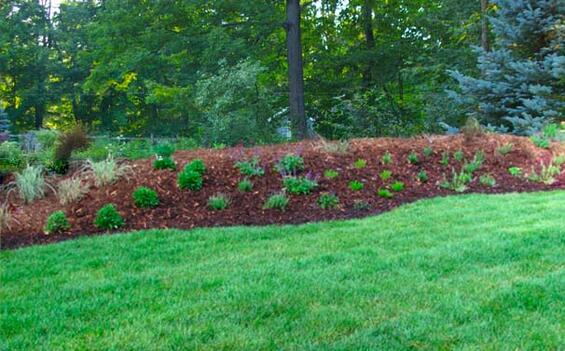
A mulched and newly planted berm has been installed to help block the flow of stormwater that heads downslope from the lawn.
- Install a berm - A berm is a mound of soil, gravel, and other sediment that acts as a “speed bump” to slow or redirect the flow of runoff. Berms can be used in areas with specific runoff problems, such as where fast-flowing water causes erosion. Berms can also be placed at the top of an eroding coastal bank to redirect runoff away from the shoreline or used as a barrier to block or redirect runoff that flows from roads or adjacent properties. The speed and volume of stormwater affect the appropriate berm size, as well as the materials that should be used for berm construction. For example, a site with fast-moving water (such as from a steep slope) would require a higher berm made of coarser materials (such as sand and gravel), which will provide an effective physical barrier for the stormwater while allowing for greater flow-through and infiltration. For average water flow, a lower berm made of a mix of sediments (such as well-drained soil and sand) will be enough to intercept and infiltrate water. Typically, a berm is most stable when its base width is twice its height. Once constructed, the berm can be covered with a layer of topsoil and planted with live plants, or the berm soil can be stabilized with a natural fiber blanket while seeds become established. Berms require routine maintenance, such as watering, pruning, weeding, mulching, and replacing vegetation as necessary. Berms should also be inspected once every 3-6 months, as well as after large storm events, to determine if plants need to be replaced or portions of the berm need repair. For more information, see the Massachusetts Clean Water Toolkit’s Filter Berm page.
Use Plants to Reduce Stormwater Pollution
Replacing impervious surfaces with planted areas—such as perennial beds, wildflower fields, shrub borders, and stands of trees—is a proven runoff control technique. The vegetation and natural land contours slow stormwater and allow it to infiltrate. The plants also filter sediments and other pollutants before surface runoff reaches the nearest wetland or waterbody, and root systems help to hold soil and sediments in place to prevent erosion. Vegetated areas are particularly effective when located downslope from walkways, driveways, or roof downspouts. Salt-tolerant grasses are a good choice adjacent to driveways, roadways, and parking lots where road salt is an issue. Trees and shrubs are also a good choice for capturing pollutants and filtering sediments from parking areas and driveways and are less likely to get smothered by sediments. Increasing the variety of grasses, perennials, shrubs, and trees that provide year-round cover allows more opportunity to slow water and absorb nutrients in all seasons. Finally, native plant species are the best choices because they are adapted to local conditions and consequently require less maintenance, watering, fertilizer, and pest control than introduced species. (Native plants also offer food, shelter, and particular traits that benefit native wildlife.)
Follow these tips to help ensure the success of planting projects:
- While native plants typically do not need watering once they become established, new plants should be watered until their limited root systems can effectively find and absorb water from the surrounding soils. To ensure plant survival, follow the specific watering instructions given on plant labels and seed packets, adjusting as necessary for weather, time of year, and site conditions. During long periods of drought or where soils are exposed to sun and wind, additional watering will likely be warranted.
- In areas where low nutrient levels cause poor plant growth, add compost or a planting soil mix to help fertilize the vegetation.
- Newly planted areas should also be weeded regularly to help the plants grow successfully and out-compete invasive plants and encroaching lawn grass. Once plants become established, less weeding will be required and only minimal pruning and cutting (such as removing dead or diseased limbs) will be needed to keep plants in proportion and healthy. Avoid cutting or deadheading spent perennials in the fall so that they can continue to provide a seed source for birds and habitat for beneficial insects over the winter (as well as a seed source for your garden in the spring).
- Where possible, organic methods should be used over chemical fertilizers, herbicides, and pesticides (see GreenScapes.org for more information).
These Stormwater Solutions for Homeowners Fact Sheets provide additional information on specific techniques for preventing runoff pollution with plants: Rain Gardens, Vegetated Buffers, Vegetated Swales, and “Green” Lawn and Garden Practices. CZM’s Coastal Landscaping website also provides landscape plans, recommended plants (many that are appropriate for both coastal and inland sites), information about environmental benefits from landscaping, and more.
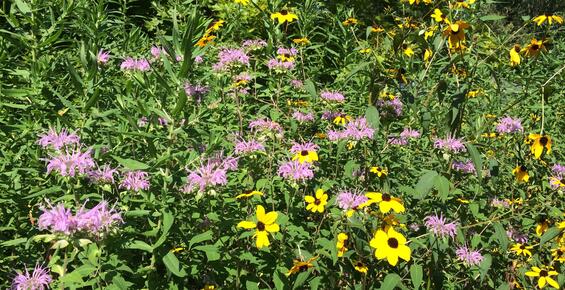
Additional Information
- For related fact sheets, see the CZM Stormwater Solutions for Homeowners fact sheet website.
- The CZM Coastal Landscaping website has details on landscaping coastal areas with salt-tolerant vegetation to reduce storm damage and erosion.
- CZM’s StormSmart Properties Fact Sheet 2: Controlling Overland Runoff to Reduce Coastal Erosion provides general approaches for homeowners to help control runoff, including limiting impervious surfaces and redirecting the flow of water away from resource areas.
- The Massachusetts Department of Environmental Protection’s Clean Water Toolkit includes Best Management Practices to prevent and control stormwater runoff, with links to fact sheets on Permeable Paving, Preserving Natural Vegetation, Soil Amendments, Dry Wells, Subsurface Drains, Green Roofs, Filter Berms, and other stormwater control options.
- The Metropolitan Area Planning Council’s fact sheets on Permeable Paving and Green Roofs give an overview of the benefits, limitations, design principles, and costs of these stormwater management options.
- Massachusetts Watershed Coalition provides resources and information about protection and restoration of watershed ecosystems, including details and designs for DIY stormwater runoff solutions for homeowners.
- The Greenscapes website focuses on nature-friendly lawn and gardening practices and includes a downloadable Greenscapes Guide that details how to use attractive “green” landscaping practices to reduce pollution, conserve water, support wildlife, and protect against climate change.
- The New Hampshire Department of Environmental Services Homeowner’s Guide to Stormwater Management Do-It-Yourself Stormwater Solutions for Your Home (PDF, 6 MB) provides comprehensive guidance and specific details on implementing various stormwater control techniques, such as pervious walkways and patios.
- The Connecticut Fund for the Environment/Save the Sound program’s ReduceRunoff.org offers information on tools to reduce stormwater impacts, such as downspout disconnections, rain barrels, rain gardens, and bioswales.
- The U.S. Environmental Protection Agency’s Soak Up the Rain website includes outreach tools, how-to guides, and many other resources on reducing the impacts of stormwater runoff.
Other Available Stormwater Solutions Fact Sheets
Fact sheets are currently available on these techniques:
- Vegetated Buffers - Trees, shrubs, high grasses, perennials, and other vegetation can be strategically planted to help slow, capture, and filter runoff and reduce stormwater impacts.
- “Green” Lawn and Garden Practices - Environmentally friendly yard care methods—such as planting native species, conserving water, and reducing fertilizer and chemical use—help to protect water quality and can save time and money.
- Rain Gardens - Rain gardens are specially designed and planted depressions in the ground that collect, filter, and treat stormwater.
- Vegetated Swales - Vegetated swales are channels with moisture-loving plants and amended soils that intercept, treat, and slowly convey stormwater runoff to where it can be effectively infiltrated.
- Minimizing Contaminants - Household contaminants—such as oil from automobiles, toxins from pesticides and cleaning products, and bacteria from pet waste and septic systems—can contribute to stormwater pollution. But simple changes at home, from reducing fertilizer use to properly disposing of batteries and other hazardous household products, can help keep inland and coastal waters clean.
- Preventing Erosion - Stormwater can carry sediments that fill storm drains, obstruct channels, smother wetlands, and cause other water quality and habitat impacts. Erosion and sediment controls can help slow and redirect stormwater, reducing erosion and capturing sediments and attached pollutants on site.
